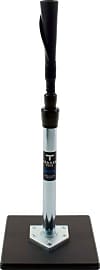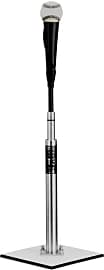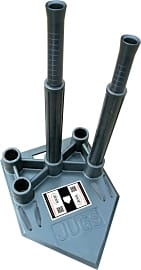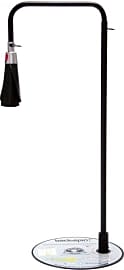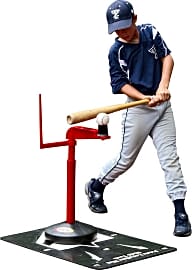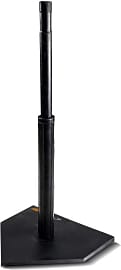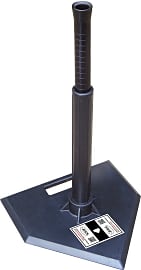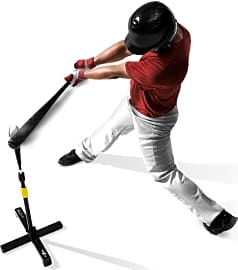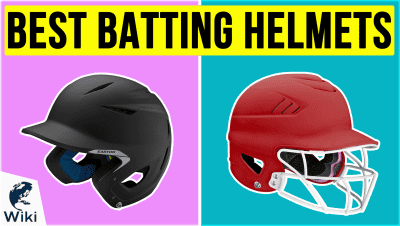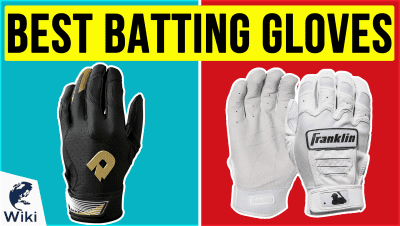The 10 Best Batting Tees

This wiki has been updated 37 times since it was first published in October of 2015. They say hitting a baseball is the hardest thing to do in sports, but regular batting practice can make this daunting task far less difficult. For any serious player, using a tee on a regular basis is a great way to sharpen your form, build consistency in your swing, and perfect your timing. This selection offers a variety of effective models for all skill levels and budgets. When users buy our independently chosen editorial recommendations, we may earn commissions to help fund the Wiki.
Editor's Notes
June 03, 2019:
We gave the Hit Zone Air a modest boost in the rankings as it not only serves as a useful tool for cultivating athletic skills at an early age, it provides hours of outdoor fun at a time when so many kids are too often cooped up inside. Sure, it’s not suitable for use with standard baseballs, but it will help youngsters successfully graduate to that next level.
The Muhl Tech Advanced was the lone new addition. Functionally, reports demonstrate that it delivers the desired result, helping hitters develop a more level swing when they’re prone to the upper cut approach. Some users note that because it’s constructed primarily with plastic, some components tend to wear down after a while.
As the CagePro Classic was no longer available, we dropped it from the list. We moved the Atec T3 out of the top spot — it’s clearly a high-quality model, with a well-designed cone, a durable base and stem, and a simple quick-release disassembly system that its users appreciate. We simply noted that its base requires a bit of extra weight to perform properly in all situations, which led us to conclude that a couple other models offer superior value.
Special Honors
Great Lakes Sports Self-Righting The height of this adaptable model can be modified in half-inch increments, making it a valuable tool for kids as young as five as well as adults looking to work on some tweaks to their form. In a way, it resembles and mimics a buoy, immediately returning to its upright position if it gets knocked over. greatlakessports.com
The Hitting Tee The Hitting Tee comes from a California manufacturer that produces hitting aids for anyone from youth baseball players to collegiate coaches. It’s designed to replicate the feel of in-game batting, and it breaks down for easy transport, so you can take your practice home with you. It’s backed by a two-year warranty, too. battingteeseaside.com
The Benefits Of Childhood Athletics
The lessons they learn in those endeavors will go a long way toward building their character and teaching them invaluable skills that they’ll use for the rest of their lives.
An education in music and participation in team sports are probably two of the most important things your children can experience while growing up. The lessons they learn in those endeavors will go a long way toward building their character and teaching them invaluable skills that they’ll use for the rest of their lives.
This is especially important given the culture in which our kids are currently growing up, with its increased emphasis on screen time and its considerable lack of physical exertion. With a diet rich in incredibly unhealthy foods, the exercise provided by organized athletics may be the only thing keeping some kids from succumbing to childhood obesity and all its attendant health problems.
On a more psychological level, being part of a team can help your child learn to engage in a group setting, to express themselves in a leadership capacity, and to come together with others in the pursuit of a common goal. All of these skills will help to make them better suited to excel in school and in the workplace.
In the realm of athletics, baseball holds a particularly special place in many of our hearts. It’s widely considered to be our national sport here in America, despite the popularity of football. What’s more, the pace of a baseball game and the sport’s team practices allows its participants more time to bond in the dugout and to develop deep, meaningful relationships. Baseball also happens to be considerably safer than football, which exposes children to the dangers of chronic micro concussions.
From a cognitive standpoint, there are both gross and fine motor skills combined in the execution of baseball plays, both at bat and on the field. While those skills will become very finely honed over the course of their childhood career, and will help them in everything from learning to drive to dancing with their high school crush, at the beginning, they’re going to need a little help. That’s where a batting tee comes in.
How To Choose A Batting Tee
When I was a kid, there wasn’t much of a choice when it came to buying a batting tee. Every tee I ever encountered in those days was a simple rubber base in the shape of home plate with a length of PVC pipe jammed into it. More often than not, if your swing was too low, you’d knock the whole thing over.
Today’s batting tees are much more advanced than the models of yore, with joints designed to collapse on impact and other features that make those old tees seem prehistoric.
Today’s batting tees are much more advanced than the models of yore, with joints designed to collapse on impact and other features that make those old tees seem prehistoric. Despite their various advancements, however, they still all serve the same basic principle, so it might seem difficult to figure out which one will best suit your child or the players on your team. Fortunately, there are a few things you can look at that will help you differentiate one model from the next, and make your selection process that much easier.
One of the most desirable features that some modern batting tees include is an adjustable height. If the batter has good overall form, but can’t seem to make solid contact with the ball, they might get quickly discouraged. That’s an easy fix if you have an adjustable height. You can raise or lower the position of the ball to compensate for the child’s natural swing tendency. That will let them make contact enough to get used to the feeling while also building confidence in their abilities. From there, you can make adjustments to the tee’s height and teach the little slugger how to make contact at these new levels.
Another important facet to consider when shopping for a batting tee is the materials out of which the base and the stand are made. For the most part, these devices are made from plastics and rubber, but a few have heavier materials toward the bottom to keep them upright if they get slammed with a bat. How the weight of the base effects the weight of the unit overall may be a deciding factor for you, as well. Ideally, you don’t want to have to reset the tee every time somebody misses beneath the ball, but you also might have to carry a few bags worth of mitts, balls, and bats to the car after practice, and adding a 10-pound tee to that haul might be pushing it.
A Brief History Of Baseball
One of the first mentions of baseball in American history came at the hands of haters. In the late 1700s, the town of Pittsfield, Massachusetts passed an ordinance banning the sport from being played anywhere within 80 yards of the town’s meeting house. Where the game itself began is a bit more of a mystery.
These leagues would often fail after a few years or be absorbed into another league, with slightly different rules for players on and off the field in each one.
Some scholars believe that the game is an offshoot of British pastimes like cricket or rounders, while others are adamant that it was a purely American invention. What we do know for sure is that its organization began in the middle of the 19th century among the upper classes of New York City. The rules in these early iterations of the game were a bit more brutal than those we see today, although the teams in the 1800s soon struck a rule from the books that had allowed fielders to get a player out by throwing the ball at him and hitting him.
Over the following decades, leagues of amateur and professional players cropped up all over the northeast. These leagues would often fail after a few years or be absorbed into another league, with slightly different rules for players on and off the field in each one. Eventually, these disparate associations all settled down into two groups: the American League, and the National Association of Professional Baseball Leagues. These two governing bodies remained intact until surprisingly recently, coming together to form today's Major League Baseball in the late 1990s.


